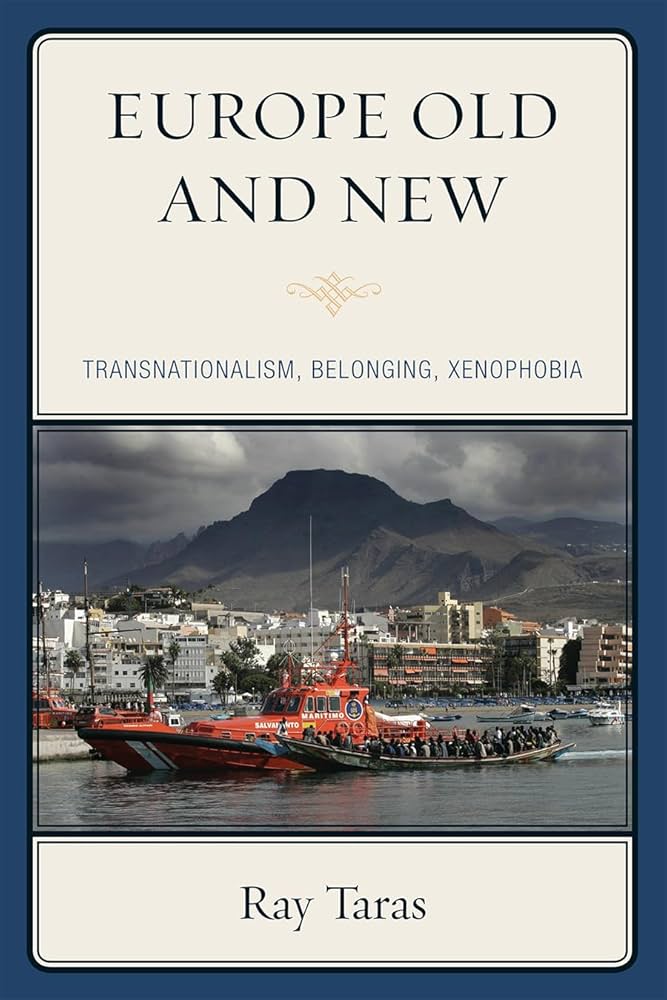Europe Old and New: Transnationalism, Belonging, Xenophobia – Ray Taras

Author: Ray Taras
Publisher: Rowman & Littlefield Publishers
Year of Publication: 2008
Print Length: 266 pages
Genre: Non-Fiction / Politics & Political Science
Area: Copanhagen, Europe, Germany, Lisbon, Poland, Scandinavia, Ukraine
Topic: Belonging, Communism, Cosmopolitanism, Identity, Immigration System, Myth & Reality,Transnationalism, Xenophobia
Is Europe indeed uniting or instead falling apart as a result of anti-immigrant prejudices, a massive Islamic influx, and ancient intra-European hatreds?
This innovative and engaging book explores this key question by examining the national and religious phobias and prejudices, antipathies and sympathies, stereotypes and heterotypes of Europe west and east. Considering the sources of Europe’s culture-based divide, Ray Taras argues that the idea of two “Europes” is grounded both in reality and myth. The accession process that brought a dozen new members into the European Union after 2004 highlighted the persisting gulf between “old” and “new” Europe. While many concrete borders between east and west were removed (commercial, legal, passport regimes), many remained (absence of a single Euro currency zone, labor market, and security community). Virtual borders too were invented or re-imagined: the postmaterialist, inclusionary, tolerant values supposedly found in old Europe versus the materialist, nationalistic, xenophobic ones of new Europe.
After reviewing the two Europes’ contrasting historical legacies, Taras examines the EU institutions designed to overcome the historical European divide. He considers the treaties, political rhetoric, citizen attitudes, and literary narratives of belonging and separation that both bind and fray the fabric of Europe. Throughout, this interdisciplinary work provides a comprehensive, hard-hitting, and unabashed review of how enlarged Europe embraces contrasting understandings of its political home and of who belongs and who does not.
Table of Contents
Acknowledgments
Introduction: Europe Old and New
Differentiating the Old from the New
The Values Gap or Values Convergence?
An Analytic Framework for Studying East-West Differences:
Fusing Institutional, Discursive, and Cultural Perspectives
A European Experience: One Trajectory
1 Europe’s Institutions and Millennial Expansion
Inevitable Convergence?
The Integrationist Momentum of the West
Elites on Integration after Maastricht
EU Institutions after the 2007 Lisbon Treaty
The Communist Legacy in the East
2 Quarreling over Institutions in an Enlarging EU
From Copenhagen Conditions to Copenhagen Agreement
Conflict over a Constitution
Hammering Out the 2007 Lisbon Treaty
Setting Standards or Double Standards?
3 Metacultural Presumptions of European Elites
Constructions of Europe
Metacultural Discourses of Political Elites
Many Europes
Overcoming Many Europes: Transnationalism, Europeanness, and Cosmopolitanism as Ideals
Europe at Fifty
4 The Politics of Phobias
Immigration and Xenophobia: The Formative Years
Immigrant Assertiveness and Its Backlash
Mapping Xenophobia and Transnationalism
Xenophobia, Its Offshoots, and Integration
Xenophobia in Europe Compared
Paranoia in the West
New Europe’s New Moral Compass? 10
Paranoia in New Europe: The Special Case of Poland
Transnationalism in the East: Ukraine?
5 European Publics and Their Phobias
Attitudes and Platitudes
Discriminatory Practices in New Europe
Rage against the Newcomer
Citizenship and Exclusion in Germany
Attitudes towards Foreigners in Germany
Attitudes towards Foreigners in Poland
Even in Scandinavia?
6 Ethnic Hierarchies
Muslims in Old Europe
Muslims in Britain: Contradictory Experiences
European Public Opinion on Muslims
Anti-Americanism as Marker of European Identity
Typologies of Anti-Americanism
7 Narrations of Home across Borders
Cultural Production in an Enlarged Europe
The European Expanses of Mircea Caˇrtaˇrescu
Home for Makine: From the Atlantic to beyond the Urals
Identity Loss in Europe: Dubravka Ugresˇi ́c
Plays about Émigrés in New and Old Europe
8 Narrating Europe’s Phobias
How the East Was to Be Civilized
Paranoia in Ismail Kadare’s Balkans Özdamar’s Linguistic Homes East and West
Self-Loathing and Antipathies in Masłowska’s Poland
The Equal-Opportunity Antipathies of Houellebecq
The Anti-Religious Views of Old Europe’s Essayists
9 The Enduring Appeal of the Culturally Bounded Home
Diversity and Integration in the National Home
A Transnational Home for Old and New Europe?
The Myth of Unity out of Diversity
Sources and Suggestions for Further
Reading
Index
About the Author

Ray Taras was born and educated in Montreal and went on to study and teach at universities in the UK, Denmark, Italy, Sweden, and the US. He publishes on issues of identity and of world literature’s importance to making sense of international politics. He has been professor of political science and past director of the world literature program at Tulane University in New Orleans. In 2013–14 he is Fulbright Distinguished Chair in European Studies at the University of Warsaw. His interviews with Carsten Jensen and Rawi Hage appear, respectively, in the May 2011 and July 2013 issues of WLT.
Source: https://www.worldliteraturetoday.org/author/ray-taras
More from Ray Taras in this library, click here.
